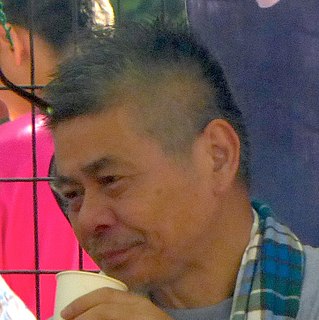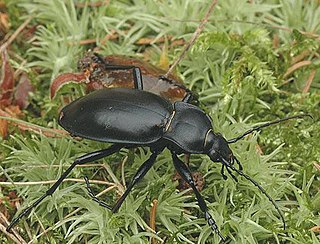Mother is a video game series that consists of three role-playing video games: Mother (1989), known as EarthBound Beginnings outside Japan, for the Family Computer; Mother 2 (1994), known as EarthBound outside Japan, for the Super Nintendo Entertainment System; and Mother 3 (2006) for the Game Boy Advance.

Shigesato Itoi is a Japanese copywriter, essayist, lyricist, game designer, and actor. Itoi is the editor-in-chief of his website and company Hobo Nikkan Itoi Shinbun. He is best known outside Japan for his work on Nintendo's Mother/EarthBound series of games, as well as his self-titled bass fishing video game.

Giygas, also known as Giegue, and Gyiyg in Japan, is a character in the Mother video game series by Nintendo, created by Shigesato Itoi. The character serves as the main antagonist and final boss of Mother and its sequel, Mother 2/EarthBound. In the series, he invades Earth in an attempt to wipe out humanity in Mother, and returns in EarthBound where he conquers the world and sends his forces into the past to prevent protagonist Ness from defeating him. The battle against Giygas, which depicts him in turmoil, drew inspiration from a Japanese film which traumatized Itoi as a child. He has received positive reception with critics referring to his battle as one of the creepiest in video games, and considered one of the greatest and most iconic video game antagonists of all time.

Mother 3 is a 2006 role-playing video game developed by Brownie Brown and HAL Laboratory and published by Nintendo for the Game Boy Advance. It is the third entry in the Mother series. The game follows Lucas, a young boy with psychic abilities, and a party of characters as they attempt to prevent a mysterious invading army from corrupting and destroying the world.

Mother, officially known outside of Japan as EarthBound Beginnings, is a 1989 role-playing video game developed by Ape and Pax Softnica and published by Nintendo for the Famicom. It is the first entry in the Mother series. It is modeled on the gameplay of the Dragon Quest series, but is set in the late 20th-century United States, unlike its fantasy genre contemporaries. Mother follows the young Ninten as he uses his great-grandfather's studies on psychic powers to fight hostile, formerly inanimate objects and other enemies. The game uses random encounters to enter a menu-based, first-person perspective battle system.

Carabus is a genus of beetles in family Carabidae. The genus is highly diverse with 94 subgenera, 959 species and 2300 subspecies, thus is the largest genus in the subfamily Carabinae. The vast majority are native to the Palearctic, but 16 Nearctic species are also known. Carabus spp. are 12–50 mm (0.47–1.97 in) long, and most species are wingless and often very colourful. These are nocturnal, predatory beetles that feed on snails, earthworms, and caterpillars. Most Carabus species were thought to have inhabited the Eurasian forest, but the species' low dispersal abilities altered the distribution of lineages within the genus.

Itoi Station is a railway station on the Muroran Main Line in Tomakomai, Hokkaidō, Japan, operated by the Hokkaido Railway Company. It is numbered "H20".
Kenpei to Barabara Shibijin is a 1957 black-and-white Japanese horror film directed by Kyotaro Namiki and written by Akira Sugimoto.

Yoshio Itoi is a Japanese former professional baseball player who played for the Hokkaido Nippon-Ham Fighters, the Orix Buffaloes, and the Hanshin Tigers. Itoi bats left-handed and throws right-handed. He played for team Japan in WBC 2013, and hit for Japan in games against Brazil and China.
Carabus albrechti is a species of either black or brown coloured ground beetle in the subfamily Carabinae that is endemic to Japan.
Carabus albrechti tsukubanus is a subspecies of ground beetle in the subfamily Carabinae that is endemic to Japan.
Carabus albrechti okumurai is a subspecies of ground beetle in the family Carabidae that is endemic to Japan.
Carabus albrechti tohokuensis is a subspecies of ground beetle in the family Carabidae that is endemic to Japan.
Carabus albrechti freyi is a subspecies of ground beetle in the family Carabidae that is endemic to Sado Island of Japan.
Carabus albrechti hagai is a subspecies of ground beetle in the family Carabidae that is endemic to Japan.
Carabus albrechti hidakanus is a subspecies of ground beetle in the family Carabidae that is endemic to Japan.
Carabus albrechti echigo is a subspecies of ground beetle in the family Carabidae that is endemic to Japan.
Carabus albrechti awashimae is a subspecies of ground beetle in the subfamily Carabinae that is endemic to Japan.
The development of Mother 3, a role-playing video game from Nintendo, spanned a total of twelve years between 1994 and 2006 with a three year gap in between, and spanned four consoles and multiple delays. Following the commercial success of its predecessor, Mother 2, Mother series creator Shigesato Itoi was given the previous game's development team.
Itoi is a village in the Nicobar district of Andaman and Nicobar Islands, India. It is located in the Nancowry tehsil.






